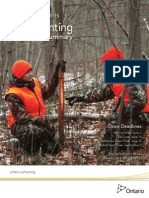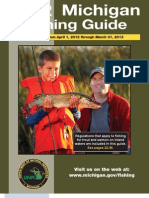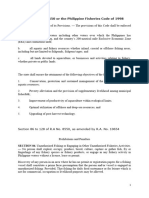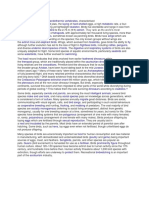Com1367 NB Eng
Com1367 NB Eng
Uploaded by
mcjuddyCopyright:
Available Formats
Com1367 NB Eng
Com1367 NB Eng
Uploaded by
mcjuddyOriginal Title
Copyright
Available Formats
Share this document
Did you find this document useful?
Is this content inappropriate?
Copyright:
Available Formats
Com1367 NB Eng
Com1367 NB Eng
Uploaded by
mcjuddyCopyright:
Available Formats
New Brunswick
Migratory Birds Hunting Regulations, 20112012
Watch for this loon on blue signs marking National Wildlife Areas and Migratory Bird Sanctuaries.
Summary
The information presented here is a summary of the law. For complete information regarding fines, general prohibitions, permitted methods of hunting and equipment, the requirement to have adequate means to retrieve birds immediately, restrictions on the use of bait, description of hunting zones, and other regulations, you may contact: Environment Canada Wildlife Enforcement Division 17 Waterfowl Lane P.O. Box 6227 Sackville, New Brunswick E4L 1G6 Tel.: 506-364-5044 Fax: 506-364-5062 Hunting Zones Zone No. 1 Saint John County south of No. 1 Highway and west of Saint John Harbour, that part of Charlotte County lying south of No. 1 Highway, and the Grand Manan Islands and Campobello Island, except the following area, which is closed to hunting: the area in the Bay of Fundy known as The Wolves, including the surrounding waters. Zone No. 2 The remainder of the Province of New Brunswick, except the following, which are closed to hunting: the estuary of the Tabusintac River, Bathurst Basin and most of Bathurst Harbour (two islands remain open and signs have been posted to indicate their locations), and the Dalhousie shoreline from the eastern tip of Dalhousie Island to the mouth of the Miller Brook and extending one kilometre offshore.
You are required to possess a valid federal Migratory Game Bird Hunting Permit with a Canadian Wildlife Habitat Conservation Stamp to hunt migratory birds in Canada. This permit and stamp are valid in all provinces and territories. Most provinces and territories have additional licence requirements for hunting migratory birds and/or to carry firearms. To know what you require, and if there are further restrictions for hunting migratory birds, please verify the applicable regulations for the province/territory where you will be hunting. Note that all required permits and licences must be in your possession while you are hunting.
Check your permit and provincial hunting regulations for additional restrictions, such as Sunday closures, minimum required distances from residences and businesses, the 1:00 p . m . closure for Tabusintac and Tracadie lagoons, and the requirement to use a dog while hunting woodcock during September. For conservation purposes, the maximum daily bag of one Barrows Goldeneye and maximum possession limit of two Barrows Goldeneye was instituted in New Brunswick in 2007. The maximum daily bag limit of one bird would not make unintentional shooting illegal; however, it would ensure that legitimate hunters who did shoot one Barrows Goldeneye would cease hunting for the day, or be aware that they would contravene regulations if they continued hunting and shot additional Barrows Goldeneye. These regulations have been put in place to provide additional protection to this population, currently listed as a species of special concern in Schedule 1 (List of Wildlife Species at Risk) of the federal Species at Risk Act. Farmland, as defined in the Migratory Birds Regulations, means land that is being used for crop production or animal husbandry (terre agricole). In National Wildlife Areas located in New Brunswick, the following regulations apply. Refer to notices posted at entrances for area-specific rules. Vehicles, ATVs and snowmobiles are prohibited unless otherwise posted. Vegetation may not be cut or damaged. Fires are not permitted. Camping is not permitted. The construction and use of tree stands is prohibited. Domestic animals may not be allowed to run at large. Outboard motors greater than 9.9 horsepower are not permitted.
Waterfowler Heritage Day provides young hunters under the age of majority with the opportunity to practice hunting and outdoor skills, learn about wildlife conservation, and reinforce safety training in a structured, supervised environment. Licensed adult hunters who serve as mentors have an opportunity to pass on their considerable skills and knowledge by offering guidance and advice to younger hunters. The following rules are in effect: to participate, young hunters under the age of majority do not require the federal Migratory Game Bird Hunting Permit; young participants must comply with all existing safety and licensing requirements found in the Firearms Act and provincial hunting regulations; participants must be accompanied by a licensed mentor over the age of majority; and mentors may not hunt or carry a firearm, and may accompany no more than two young hunters.
Non-toxic shot must be used in all areas of Canada to hunt migratory game birds, except for woodcock, Band-tailed Pigeons and Mourning Doves. Within National Wildlife Areas, the possession of lead shot is prohibited for all hunting, including the hunting of migratory birds and upland game birds. Hunters should consult provincial or territorial regulations for additional restrictions. For those birds still hunted with lead shot, remove the lead shot before cooking whenever possible in order to reduce your exposure to contaminants. As well, remove the skin and fat from fish-eating birds before cooking them. HELPFUL TIP Canadians may be exposed to avian-borne viruses when hunting or handling migratory birds and other wild game. Environment Canada recommends the following website, maintained by the Public Health Agency of Canada, for information about minimizing the risk of exposure: www.phac-aspc.gc.ca
CRIME STOPPERS The Canadian Wildlife Service has joined forces with New Brunswick Crime Stoppers to address offences concerning migratory birds. Anyone wishing to report illegal hunting activities, illegal selling of birds or other offences related to migratory birds is asked to call Crime Stoppers at 1-800-222-TIPS (8477). Y call is anonymous, and you may be eligible for a cash reward. our
OPEN SEASONS IN NEW BRUNSWICK (No open season for Harlequin Ducks)
Ducks (other than Harlequin Ducks) and geese WATERFOWLER HERITAGE DAY Sept. 17, 2011 Ducks (other than Harlequin Ducks), geese (other than Canada Geese and Cackling Geese) and snipe Oct. 15, 2011, to Jan. 4, 2012 Additional season for Common and Red-breasted mergansers, Long-tailed Ducks, eiders and Woodcock scoters in coastal waters only Feb. 1 to Feb. 24, 2012 Sept. 15 to Nov. 30, 2011
Area Zone No. 1
Canada Geese and Cackling Geese Sept. 6 to Sept. 16, 2011(a), and Oct. 15, 2011, to Jan. 4, 2012 Sept. 6 to Sept. 16, 2011(a), and Oct. 1 to Dec. 18, 2011
Zone No. 2
Sept. 17, 2011
Oct. 1 to Dec. 18, 2011
No additional season
Sept. 15 to Nov. 30, 2011
(a) In Zone No. 1 and Zone No. 2, hunting for Canada Geese and Cackling Geese during the period of September 6 to September 16, 2011, is allowed only on farmland.
BAG AND POSSESSION LIMITS IN NEW BRUNSWICK
Limits Daily bags Possession
(a) (b) (c) (d) (e)
Ducks (other than Common and Redbreasted mergansers, Long-tailed Ducks, Harlequin Ducks, eiders and scoters) 6(a) 12(b)
Common and Red-breasted mergansers, Long-tailed Ducks, eiders and scoters 6(c) 12(d)
Geese 5(e) 10(e)
Woodcock 8 16
Snipe 10 20
Not more than 3 may be American Black Ducks, and not more than 1 may be Barrows Goldeneye. Not more than 6 may be American Black Ducks, and not more than 2 may be Barrows Goldeneye. Not more than 4 may be scoters; and in Zone No. 1 from February 1 to February 24, 2012, not more than 4 eiders may be taken daily. Not more than 8 may be scoters; and in Zone No. 1 from February 1 to February 24, 2012, not more than 8 eiders may be possessed. Not more than a total of 3 additional Canada Geese or Cackling Geese, or any combination of them, may be taken daily and not more than a total of 6 additional Canada Geese or Cackling Geese, or any combination of them, may be possessed from September 6 to September 16, 2011, inclusive.
REPORT YOUR MIGRATORY BIRD BANDS: CALL 1-800-327-BAND (2263) OR GO TO: WWW.REPORTBAND.GOV
ISSN 1925-6949
You might also like
- Bird Order ChartDocument6 pagesBird Order ChartTheTeachersDesk.info100% (3)
- The Ugly DucklingDocument5 pagesThe Ugly DucklingSheen aballeNo ratings yet
- NH Freshwater Fishing GuideDocument64 pagesNH Freshwater Fishing GuideMirkoNo ratings yet
- New York Freshwater Fishing GuideDocument84 pagesNew York Freshwater Fishing GuideGary JeanfaivreNo ratings yet
- TN Hunting Guide 2011Document100 pagesTN Hunting Guide 2011redrckt442No ratings yet
- Waterfowl Guide: Season Information For: Early Teal Early Canada Goose Regular Seasons Light Goose Conservation ActionDocument15 pagesWaterfowl Guide: Season Information For: Early Teal Early Canada Goose Regular Seasons Light Goose Conservation ActionNEGameandParksNo ratings yet
- Ontario_Migratory_Birds_Hunting_SummaryDocument3 pagesOntario_Migratory_Birds_Hunting_SummaryDumDumNo ratings yet
- South Carolina Hunting RegulationsDocument48 pagesSouth Carolina Hunting RegulationsGeorge JonesNo ratings yet
- Season Information For:: Early Teal Duck and Goose Light Goose Conservation OrderDocument16 pagesSeason Information For:: Early Teal Duck and Goose Light Goose Conservation OrderNEGameandParksNo ratings yet
- Saltwater Fishing: General InformationDocument6 pagesSaltwater Fishing: General InformationmitsebucanonNo ratings yet
- 2012-2013 New Mexico Fishing RegulationsDocument24 pages2012-2013 New Mexico Fishing RegulationsRoeHuntingResourcesNo ratings yet
- 2024 Waterfowl Regs For MNDocument33 pages2024 Waterfowl Regs For MNreillymed5668No ratings yet
- MFish Recreational HandbookDocument96 pagesMFish Recreational HandbookMark 'Mcduff' StevensonNo ratings yet
- Teaxas 1Document16 pagesTeaxas 1VediNo ratings yet
- Puget Sound Fishing RulesDocument133 pagesPuget Sound Fishing RulesClifford KilwienNo ratings yet
- Sportsmen's Report: Safety Tips For This Hunting SeasonDocument4 pagesSportsmen's Report: Safety Tips For This Hunting SeasonPAHouseGOPNo ratings yet
- Division of Fisheries & Wildlife: HIP Survey Required For All Migratory Gamebird Hunters!Document2 pagesDivision of Fisheries & Wildlife: HIP Survey Required For All Migratory Gamebird Hunters!Theo BlevinsNo ratings yet
- Recreation FishDocument80 pagesRecreation FishDarren PauliNo ratings yet
- Baitfish Primer: A Guide To Identifying and Protecting Ontario'S BaitfishesDocument40 pagesBaitfish Primer: A Guide To Identifying and Protecting Ontario'S BaitfishesbenNo ratings yet
- New Jersey 2011-2012 Migratory Bird Regulations BookletDocument2 pagesNew Jersey 2011-2012 Migratory Bird Regulations BookletAmmoLand Shooting Sports NewsNo ratings yet
- Fishinghandbook OnlineDocument76 pagesFishinghandbook OnlineMihaiDumitru6No ratings yet
- KY HuntingDocument68 pagesKY HuntingalabamageneNo ratings yet
- J.W. CorbettDocument6 pagesJ.W. Corbetttromboninator4000No ratings yet
- MD Waterfowl2011Document3 pagesMD Waterfowl2011rem2557No ratings yet
- Kyhunt14-15 Small GameDocument2 pagesKyhunt14-15 Small Gameapi-259970749No ratings yet
- Rules About Fishing in IowaDocument24 pagesRules About Fishing in IowaMichelle O'NeillNo ratings yet
- 2023 Fishing Regulations Final for WebDocument96 pages2023 Fishing Regulations Final for WebLouis RassabyNo ratings yet
- Michigan Michigan Fishing Guide Fishing Guide: Rules Apply From April 1, 2020 - March 31, 2021Document68 pagesMichigan Michigan Fishing Guide Fishing Guide: Rules Apply From April 1, 2020 - March 31, 2021Tyler JonesNo ratings yet
- Bahía de Los Ángeles BrochureDocument2 pagesBahía de Los Ángeles BrochureSaruhén Avila MorenoNo ratings yet
- 2020 0506mj03 SocialdistancingDocument2 pages2020 0506mj03 SocialdistancingAnonymous arnc2g2NNo ratings yet
- Mastering the Art of Fishing in the Florida Gulf of Mexico Copyright © 2023 Chad Beadle 2Document32 pagesMastering the Art of Fishing in the Florida Gulf of Mexico Copyright © 2023 Chad Beadle 2cmbead4283No ratings yet
- River SoarDocument28 pagesRiver SoardaveagriffNo ratings yet
- New Jersey Fall 2016 Furbearer Management NewsletterDocument9 pagesNew Jersey Fall 2016 Furbearer Management NewsletterAmmoLand Shooting Sports NewsNo ratings yet
- National Patrimony (Property Inherited From One's Father or Male Ancestor) and 3 Ways To Access them-ARTICLE XII of The 1987 Constitution ProvidesDocument2 pagesNational Patrimony (Property Inherited From One's Father or Male Ancestor) and 3 Ways To Access them-ARTICLE XII of The 1987 Constitution ProvidesKaren K. GaliciaNo ratings yet
- General Trapping Restrictions: Trapping Regulations and InformationDocument2 pagesGeneral Trapping Restrictions: Trapping Regulations and InformationColumbia GomezNo ratings yet
- Contacts For More Information: State Fishing RegulationsDocument1 pageContacts For More Information: State Fishing RegulationsStephen WilliamsNo ratings yet
- Minnesota Waterfowl Regulations 2023Document32 pagesMinnesota Waterfowl Regulations 2023Celeste EdenloffNo ratings yet
- Nonnative Pet Amnesty Day Is Nov. 5 at Sea WorldDocument8 pagesNonnative Pet Amnesty Day Is Nov. 5 at Sea WorldFlorida Fish and Wildlife Conservation CommissionNo ratings yet
- Species Rules Species RulesDocument27 pagesSpecies Rules Species RulesJazz KennyNo ratings yet
- Migratory FAQDocument3 pagesMigratory FAQroryNo ratings yet
- Hand Out - Without BlankDocument4 pagesHand Out - Without BlankdollyccruzNo ratings yet
- Fb32 Tourist Anglers FormattedDocument4 pagesFb32 Tourist Anglers FormattedBob WattendorfNo ratings yet
- Fb30 Newrules FormattedDocument5 pagesFb30 Newrules FormattedBob WattendorfNo ratings yet
- 2014 Ontario Hunting RegulationsDocument100 pages2014 Ontario Hunting Regulationsmusgrave762No ratings yet
- Fishing Reg SupplementDocument32 pagesFishing Reg SupplementMichael OliverNo ratings yet
- Migratory Bird Hunting Regulations SummaryDocument40 pagesMigratory Bird Hunting Regulations SummaryTheo BlevinsNo ratings yet
- Fisher's GuideDocument42 pagesFisher's Guidemarielumbu26No ratings yet
- Ra 8550Document46 pagesRa 8550Red Convocar100% (9)
- 2009 FishingDocument68 pages2009 FishingAdnan GrebovićNo ratings yet
- DNR 2021 Fishing GuideDocument68 pagesDNR 2021 Fishing GuideRoxanne WerlyNo ratings yet
- WDFW 01176Document149 pagesWDFW 01176Mark ReinhardtNo ratings yet
- Fishing Guide: Rules Apply From April 1, 2012 Through March 31, 2013Document40 pagesFishing Guide: Rules Apply From April 1, 2012 Through March 31, 2013Mike BoersmaNo ratings yet
- Falc GuideDocument28 pagesFalc GuideMark AbellaNo ratings yet
- 2015 Hunters and Trappers Guide September 22Document64 pages2015 Hunters and Trappers Guide September 22CommancheSixNo ratings yet
- Stop Poaching AbaloneDocument2 pagesStop Poaching Abaloneapi-240053686No ratings yet
- 2014 Nevada Hunting GuideDocument76 pages2014 Nevada Hunting GuideAaron MeierNo ratings yet
- English Salmon Regs 2024 WebDocument2 pagesEnglish Salmon Regs 2024 Webandrewgallagher.teflNo ratings yet
- NATRES Laws 12-18Document53 pagesNATRES Laws 12-18Wilfredo Guerrero IIINo ratings yet
- The Ultimate Cheat Code: FLOUNDER: The Definitive Flounder Playbook for the Grand Strand and the CarolinasFrom EverandThe Ultimate Cheat Code: FLOUNDER: The Definitive Flounder Playbook for the Grand Strand and the CarolinasNo ratings yet
- SteeringchecklistDocument2 pagesSteeringchecklistmcjuddyNo ratings yet
- FallchecklistDocument3 pagesFallchecklistmcjuddyNo ratings yet
- SpringchecklistDocument1 pageSpringchecklistmcjuddyNo ratings yet
- Downloaded From Manuals Search EngineDocument118 pagesDownloaded From Manuals Search EnginemcjuddyNo ratings yet
- Pre. KG Activity #3 English Maths & ScienceDocument10 pagesPre. KG Activity #3 English Maths & ScienceIyesusgetanewNo ratings yet
- Mitsubishi Forklift Fb15krt Service ManualDocument23 pagesMitsubishi Forklift Fb15krt Service ManualnaiqhinderNo ratings yet
- A - The Man and His Activities: Cod e Image Phonetic Value Ideogram and Phonogram Illustrated Article UseDocument45 pagesA - The Man and His Activities: Cod e Image Phonetic Value Ideogram and Phonogram Illustrated Article UseSlopa StefanNo ratings yet
- Jonathan Livingston SeagullDocument9 pagesJonathan Livingston SeagullMarjan AgnoNo ratings yet
- Bird Names in Venda (Tshiven A) Johan Meyer - Academia - EduDocument1 pageBird Names in Venda (Tshiven A) Johan Meyer - Academia - EduKhumbelo TshiololiNo ratings yet
- The ApostropheDocument23 pagesThe ApostrophelindsfrNo ratings yet
- Hines B Ducks at A Distance A Waterfowl Identification GuideDocument56 pagesHines B Ducks at A Distance A Waterfowl Identification GuideNeliksNo ratings yet
- February 2002 White Bird Newsletter Peace River Audubon SocietyDocument4 pagesFebruary 2002 White Bird Newsletter Peace River Audubon SocietyPeace River Audubon SocietyNo ratings yet
- The Boy Who Flew Too HighDocument1 pageThe Boy Who Flew Too HighroccelfsabdulaNo ratings yet
- Excerpt From "A Most Remarkable Creature: The Hidden Life and Epic Journey of The World's Smartest Birds of Prey"Document4 pagesExcerpt From "A Most Remarkable Creature: The Hidden Life and Epic Journey of The World's Smartest Birds of Prey"OnPointRadioNo ratings yet
- Rajasthan BrochureDocument5 pagesRajasthan Brochurekrishnaghy1976No ratings yet
- RIS_SWNR_RSN 2552Document24 pagesRIS_SWNR_RSN 2552Aya JnavNo ratings yet
- Owls OverheadDocument9 pagesOwls OverheadPhương Trang LêNo ratings yet
- IB 17 1 RawatETAL YellowleggedButtonquailDocument2 pagesIB 17 1 RawatETAL YellowleggedButtonquailsumit aryaNo ratings yet
- Instant Download (Ebook PDF) Organizational Behavior: A Skill-Building Approach 2nd Edition PDF All ChapterDocument49 pagesInstant Download (Ebook PDF) Organizational Behavior: A Skill-Building Approach 2nd Edition PDF All Chaptersibanmuydn79100% (11)
- European Nightjar: Jump To Navigation Jump To SearchDocument18 pagesEuropean Nightjar: Jump To Navigation Jump To SearchKYAWNo ratings yet
- Birds (Aves) Are A Group Of: WingsDocument1 pageBirds (Aves) Are A Group Of: WingsGabriel Angelo AbrauNo ratings yet
- Suomi - Riistamaana 2020 Eng-1Document8 pagesSuomi - Riistamaana 2020 Eng-1vihkr9506No ratings yet
- Do Crows Hold Funerals For Their Dead?Document2 pagesDo Crows Hold Funerals For Their Dead?shesh_kgNo ratings yet
- Reading Comprehension - Practice - KeysDocument4 pagesReading Comprehension - Practice - Keyschich xagiaoNo ratings yet
- Ep Islands 2Document15 pagesEp Islands 2Manas GargNo ratings yet
- FLML300277Document41 pagesFLML300277miasmatcanNo ratings yet
- Birds of Toronto - A Guide To Their Remarkable World (2011)Document72 pagesBirds of Toronto - A Guide To Their Remarkable World (2011)T.O. Nature & DevelopmentNo ratings yet
- Specimen English Questions: 10+ Deferred EntryDocument4 pagesSpecimen English Questions: 10+ Deferred EntryJack HawkinsNo ratings yet
- (Ebooks PDF) Download Foundations of Materials Science and Engineering 7th Edition William F. Smith Professor - Ebook PDF Full ChaptersDocument25 pages(Ebooks PDF) Download Foundations of Materials Science and Engineering 7th Edition William F. Smith Professor - Ebook PDF Full Chapterswaskidaina100% (6)
- April 2008 Warbler Newsletter Portland Audubon SocietyDocument12 pagesApril 2008 Warbler Newsletter Portland Audubon SocietyPortland Audubon SocietyNo ratings yet
- Zeiss Nature Catalog 2019-2020Document31 pagesZeiss Nature Catalog 2019-2020hutz5000No ratings yet
- Little Bird's Big DreamDocument1 pageLittle Bird's Big Dreamflorence.soliven002No ratings yet





























































































